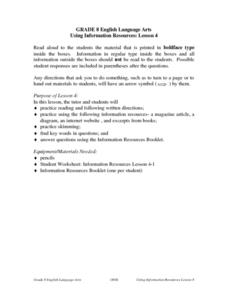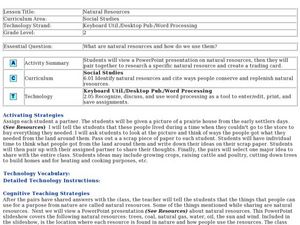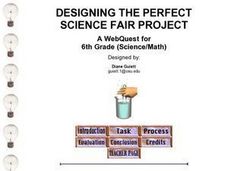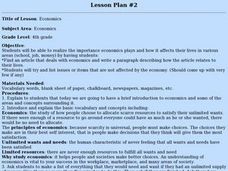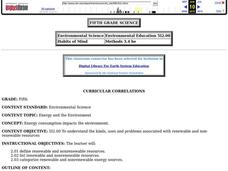Curated OER
All Wrapped Up
Learners explore packaging. In this cross-curriculum lesson, students bring in samples of food packaging and identify the packaging as natural or manufactured.
Curated OER
The Goat in the Rug
Students identify producers, resources and goods. In this economics lesson, students read the book The Goat in the Rug and define producers, resources, and intermediate goods. Students construct a rug which depicts the story of rug...
Curated OER
Hometown Heroes
Students identify the factors of starting a business. In this business lesson, students interview a local entrepreneur and discuss the factors that influenced their decision to start a business. Students create a composition based upon...
Curated OER
The Environment and the Community
Young scholars observe their environment and come up with ways to protect it. In this environment lesson plan, students discuss pollution and ways to prevent it. Then they create a poster with drawings that show a goal to reduce...
Curated OER
Using Information Resources
Eighth graders engage in a lesson that is intended to develop the skills of research to find the proper resources needed to find information. The lesson includes dialogue boxes that is intended for the teacher to use for direct...
Curated OER
Population Needs vs. Population Deeds
Learners examine the recent population explosion of the world. After watching a demonstration on closed systems, they identify the role humans have on the depletion of natural resources and lowering the standard of living. To end the...
Curated OER
Natural Resources
Fifth graders begin the lesson by identifying the different types of natural resources. As a class, they discuss how environments are destructed and how the loss of one natural resource can affect the economy. Using a map, they label the...
Curated OER
Thinking about Energy
Middle schoolers examine their understandings about energy concepts by completing an online survey. Students participate in a class discussion about their uses of resources and the differences between perpetual, renewable, and...
Curated OER
Renewable vs. Non-Renewable Resources
Fifth graders, after brainstorming why conservation of resources is important, distinguish between renewable and non-renewable resources. They make a list of different types of natural resources on the board and then sort them into two...
Curated OER
Breaking the Food Chain
Students investigate the food chain. They brainstorm questions about the human food chain and explain what would happen to living things in the food chain if organisms or resources were removed. They role-play situations in which the...
Curated OER
Resources
Students watch a video in which they tour a factory. While viewing the video, they take notes on the types of resources they see and group them according to natural, human or capital resources. They discover the difference between...
Curated OER
Elders as Resources Lesson Plan
Students participate in an Elders as Resources project. In groups, they work with their elders of the community to exchange viewpoints in which they can discover aspects about each other previously unknown. They also examine the case...
Curated OER
Opportunity Cost
Young scholars explore the concept of opportunity cost. Classmates discuss, orally and in writing, a time when they had to make a choice when all choices seemed worthwhile. They explore the impact of making decisions when resources are...
Curated OER
Scarcity and Choices
First graders gain an understanding of the scarcity of resources and how it affects the choices that we make in our everyday lives. Students will participate in a variety of activities such as literature analysis, shopping, journal...
Curated OER
Spedwards
Students discuss what makes up a community. Students elect officials of their community and complete an application for the position. Students research jobs within the community and hold a job fair where parents come to school and share...
Curated OER
Designing the Perfect Science Fair Project Webquest
Sixth graders examine the Scientific Method and define their topic of interest. Students familiarize themselves with how to utilize their resources and create note cards. Students create their written report and display of their...
Curated OER
Economics
Students discover the resources that are available for consumer protection. In a database, they are responsible for entering two new vocabulary words each semester along with a sentence using the word. In groups, they create a...
Curated OER
Economics: The Scarcity Principle
Learners discover how scarcity leads to economic choices. They examine its effect on individuals, business, and governments. Students simulate various scenarios to determine the role scarcity plays in each.
Curated OER
Promote Your Media Center!
Students use a webquest to use Research Process Model (RPM), and the information they gather to prove to everyone what a wonderful and helpful resource the Library/Media Center really is.
Curated OER
TE Activity: The Great Divide
Students simulate the distribution of nonrenewable energy resources using cookies. They determine how the world's growing population effects the equitable distribution of these resources. They look at how engineers work to develop...
Curated OER
Water, Water Everywhere
Students observe and describe ways water is used in their homes and communities. They determine the source of their water. Students determine ways they can save and protect their water.
Curated OER
Energy and the Environment
Fifth graders define terms associated with renewable and nonrenewable resources. They identify materials that are renewable and nonrewable. They categorize a list into the correct type of resource.
Curated OER
Because We Can, Should We?
High schoolers identify a position on an issue of geographic importance and support it They read the story "By the Waters of Babylon," and write a paragraph explaining what they think the relationship between Babylon and the Biblical...
Curated OER
Treasure of the Tar
High schoolers, using an atlas, locate the region known as the "Tar Sands" in the Central Plains of Canada. They hypothesize about the future economic potential of this natural resource. They create a poster about the Tar Sands industry...






